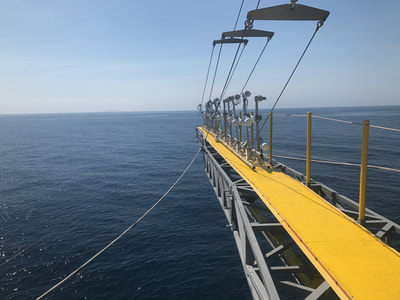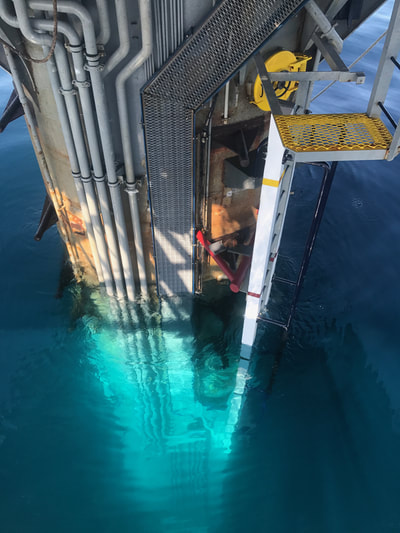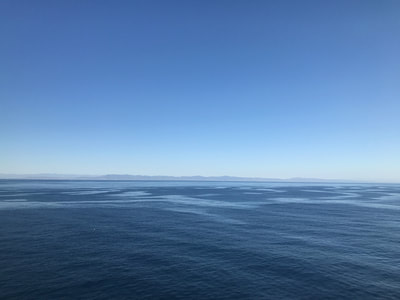|
A casual observer from a bluff or hillside overlooking the ocean may notice that the sea surface appears rough and smooth. Moreover, a less casual observer, may discern that this smoothness and roughness can take the form of quasilinear or meandering bands; and even less casual and patient observer, will notice that these bands move.
These bands, in some cases, are caused by nonlinear internal waves propagating across the coastal oceans, invisible to the eye except for when the conditions are right for these bands to form. These "internal" waves, are similar to the surface waves we typically see across the ocean, but they occur within the water column and they travel along the boundaries between water masses with slightly different densities (think: the thermocline). Sea-going oceanographers and meteorologists have long seen these bands and many may have pontificated on their generation and/or impact on the atmosphere. During our recent field campaign, a truly fortuitous combination of measurement capabilities with environmental conditions gave us the opportunity to shed some quantitative light on this subject. Some food for thought; or ammunition for the next jaunty debate held within a ship's galley or at a experimental shore site. The full manuscript is available here: https://agupubs.onlinelibrary.wiley.com/doi/full/10.1029/2019GL083374
0 Comments
A little late in updating here, but on 1/1/2019 I became a member of the AMS Committee on Air-Sea Interaction. I am excited to be a part of this body and look forward to working with my fellow members to facilitate the continual development of the air-sea interaction research community. For more information on the Committee and the AMS please visit:
https://www.ametsoc.org/index.cfm/stac/committees/committee-on-air-sea-interaction/ More news and updates to come... The 22nd day of September through the 25th day of October, this year two thousand and seventeen. Dates that I do not think I will easily forget, though at this point they nearly exist in my memory as a single coagulated mass. These dates mark the time I spent about the Floating Instrument Platform (FLIP), which is now "owned" by ONR, but run out the Scripps Institution of Oceanography, as part of the CASPER project and as the first significant action at my new post at the Naval Postgraduate School working under Professor Qing Wang. It's quite a thing to have to be at sea on FLIP, get up to speed on a completely new and vastly complex project, all the while try to make a decent first impression with your-now-colleagues. Typically, close and confined quarters are not the optimal location for showing your best side, especially when those close and confined quarters are aboard a ship. For my part, this was an amazing experience and I was humbled to be able to work on one of the most regarded research vessels/platforms in the oceanographic and atmospheric community. Not only was the experience of being aboard FLIP unique, but I was very excited to be apart of CASPER and the prospect of working on this project is very intriguing. For the uninitiated, FLIP is not a ship. It is a platform that looks like a 100+ m long pipe attached to the stern of research vessel that looks like it was cut-off at the knees and put in a trash compactor. This platform lacks any ambulatory capability and is towed out to the study site and then flipped. The flipping takes a while to go from horizontal to ~50 degrees, and about 30 seconds to go from 50 degrees to vertical. When all is said and done, FLIP looks like some abstract artist's nautical rendition probing the folly's of man and oceanographic exploration.
When FLIP is flipped, the cats come out of the bag and everyone (crew+science) scramble to set-up the platform (lower the booms), unpack the gear (the crew of FLIP said that the CASPER-amount of gear was the most scientific equipment they've seen on a research cruise, ever), and set-up the sensors. All of this is done across 4 vertically stacked decks, connected using almost vertical death ladders that enjoy being slippery, steel grating, and a useable floor space about the size of my 1400 sq ft. apartment's living room---keep in mind 4 separate research groups are trying to work all at the same time. When everything is installed, FLIP must looks the most alien of sites bursting out of the ocean. No wonder every passerby from helicopters, tanker ships, weekend warrior sport fishermen, and two old chaps looking for the "Santa Monica basin buoy' cruises by for a gander. And that's just the setting up..... All-in-all, it was a fascinating 6 weeks and I do truly hope I can go aboard FLIP again. From a research perspective, there is no other platform that exists for scientific observation that can give you the same opportunity to measure actual geophysical processes with such minimal contamination as FLIP. During CASPER, our group and others were making laboratory-esque measurements in real oceanic and atmospheric conditions. At some points, one almost forgets that we were at sea. It was an honor, as my last action as Student Rep. to the RSMAS academic committee as well as chair of the RSMAS SLED committee, to be able to present Professor Roland Romeiser with the Outstanding Mentor Award for 2017.
www.rsmas.miami.edu/blog/2017/05/26/outstanding-mentor-student-award-winners/ Roland is truly deserving of this award. He is an excellent teacher and compassionate mentor to many students. It has been a pleasure to be a student working within the same department and research group as Roland. I was really happy to be able to pass this on to him before signing off my time at RSMAS. April 14th, 2017 will be a day for me to remember, the 1st day of my 28th year.
Our spray paper got a little attention from the university...
http://rsmas.miami.edu/news-events/press-releases/2016/researchers-study-sea-spray-to-improve-hurricane-intensity-forecasting/http://rsmas.miami.edu/news-events/press-releases/2016/researchers-study-sea-spray-to-improve-hurricane-intensity-forecasting/ http://scienmag.com/researchers-study-sea-spray-to-improve-hurricane-intensity-forecasting/
Much of what I presented is summarized in some recent papers from our group...
> iopscience.iop.org/article/10.1088/1755-1315/35/1/012008/meta > journals.ametsoc.org/doi/abs/10.1175/JAS-D-15-0249.1 Also, just as a curiosity, I was told the tidal swings in Brest (and Brittany in general) are very large. I checked the local tide gauge and during the conference we saw tidal swings > 4 m....thats crazy. Here's a picture to prove it. I am standing on a rock outcropping on the shore near Point St. Matthieu and looking at some tide pools. The one in the foreground is > 3 m above the one in the background, which is at sea level. I had to climb UP 3 m to get to a tide pool.... Some shameless self-promotion. Thank you to the reviewers and editors for their thoughtful comments that really improved this study. Also, I'd like to thank my co-authors and the SUSTAIN lab at RSMAS for their help and support.
|
Archives
January 2023
Categories |
||||||||||||||||
Proudly powered by Weebly














 RSS Feed
RSS Feed